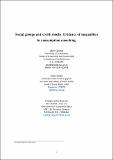Files in this item
Social groups and credit shocks : evidence of inequalities in consumption smoothing
Item metadata
| dc.contributor.author | Saxena, Vibhor | |
| dc.contributor.author | Bindal, Ishaan | |
| dc.contributor.author | LeMay-Boucher, Philippe | |
| dc.date.accessioned | 2022-04-15T23:41:06Z | |
| dc.date.available | 2022-04-15T23:41:06Z | |
| dc.date.issued | 2020-12 | |
| dc.identifier | 270807753 | |
| dc.identifier | 8239887c-d95e-4d52-b4a2-be4c412597c8 | |
| dc.identifier | 85092889977 | |
| dc.identifier | 000590013400025 | |
| dc.identifier.citation | Saxena , V , Bindal , I & LeMay-Boucher , P 2020 , ' Social groups and credit shocks : evidence of inequalities in consumption smoothing ' , Economic Analysis and Policy , vol. 68 , pp. 311-326 . https://doi.org/10.1016/j.eap.2020.10.004 | en |
| dc.identifier.issn | 0313-5926 | |
| dc.identifier.other | ORCID: /0000-0001-9411-5527/work/82501124 | |
| dc.identifier.uri | https://hdl.handle.net/10023/25195 | |
| dc.description.abstract | A strand of research holds the view that restricting access to credit to regulate over-borrowing can worsen consumers’ financial condition. Another strand of research holds the view that access to credit in the developing countries with subprime credit markets is determined by social groupings and ethnic affiliations. By merging these two strands of research, we investigate the impact of Andhra Pradesh microfinance act (2010) on the consumption expenditure of marginalised social groups and the upper caste Hindu groups in India. We construct an aggregated district level panel data for eight quarters and estimate the impact of unanticipated policy change. The results of our analysis show that the sudden restriction of access to credit has relatively larger impact on the consumption levels of the marginalised social groups: lower castes, tribes, and Muslims. The findings also confirm the failure of contingency policy enacted for smoothing consumption. | |
| dc.format.extent | 16 | |
| dc.format.extent | 822223 | |
| dc.language.iso | eng | |
| dc.relation.ispartof | Economic Analysis and Policy | en |
| dc.subject | Financial deleveraging | en |
| dc.subject | Social insurance | en |
| dc.subject | Consumption smoothing | en |
| dc.subject | Microfinance | en |
| dc.subject | Andhra Pradesh | en |
| dc.subject | HG Finance | en |
| dc.subject | T-NDAS | en |
| dc.subject | SDG 1 - No Poverty | en |
| dc.subject | SDG 5 - Gender Equality | en |
| dc.subject | SDG 8 - Decent Work and Economic Growth | en |
| dc.subject.lcc | HG | en |
| dc.title | Social groups and credit shocks : evidence of inequalities in consumption smoothing | en |
| dc.type | Journal article | en |
| dc.contributor.institution | University of St Andrews. School of Economics and Finance | en |
| dc.identifier.doi | 10.1016/j.eap.2020.10.004 | |
| dc.description.status | Peer reviewed | en |
| dc.date.embargoedUntil | 2022-04-16 |
This item appears in the following Collection(s)
Items in the St Andrews Research Repository are protected by copyright, with all rights reserved, unless otherwise indicated.

